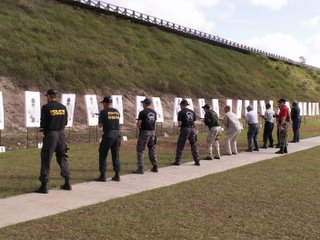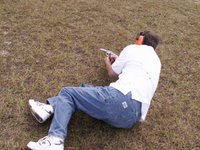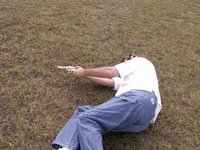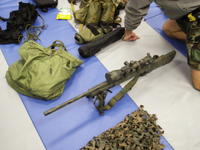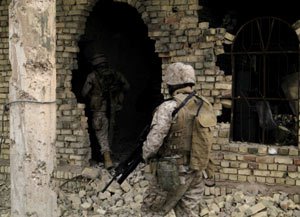
The following is an excerpt of the "
Brief History of the United States Marine Corps."
On November 10, 1775, the Continental Congress meeting in Philadelphia passed a resolution stating that "two Battalions of Marines be raised" for service as landing forces with the fleet. This resolution, established the Continental Marines and marked the birth date of the United States Marine Corps.
These Continental Marines’ first amphibious raid was into the Bahamas in March 1776, under the command of Captain (later Major) Samuel Nicholas.
Following the Revolutionary War and the formal re-establishment of the Marine Corps on 11 July 1798, Marines saw action in the quasi-war with France, landed in Santo Domingo, and took part in many operations against the Barbary pirates along the "Shores of Tripoli" and during the War of 1812 the Marines fought alongside Andrew Jackson in the defeat of the British at New Orleans.
During the Mexican War (1846-1848), Marines seized enemy seaports on both the Gulf and Pacific coasts. A battalion of Marines joined General Scott's army at Pueblo and fought all the way to the "Halls of Montezuma," Mexico City.
Following the Spanish-American War (1898), in which Marines performed with valor in Cuba, Puerto Rico, Guam, and the Philippines, the Corps entered an era of expansion and professional development. It saw active service in the Philippine Insurrection (1899-1902), the Boxer Rebellion in China (1900). and in numerous other nations, including Nicaragua, Panama, Cuba, Mexico, and Haiti.
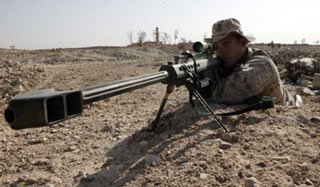
In World War I the Marine Corps distinguished itself on the battlefields of France as the 4th Marine Brigade earned the title of "Devil Dogs" for heroic action during 1918 at Belleau Wood, Soissons, St. Michiel, Blanc Mont, and in the final Meuse-Argonne offensive. Marine aviation, which dates from 1912, also played a part in the war effort, as Marine pilots flew day bomber missions over France and Belgium. More than 30,000 Marines had served in France and more than a third were killed or wounded in six months of intense fighting.
During the two decades before World War II, the Marine Corps began to develop in earnest the doctrine, equipment, and organization needed for amphibious warfare. The success of this effort was proven first on Guadalcanal, then on Bougainville, Tarawa, New Britain, Kwajalein, Eniwetok, Saipan, Guam, Tinian, Peleliu, Iwo Jima, and Okinawa. By the end of the war in 1945, the Marine Corps had grown to include six divisions, five air wings, and supporting troops. Its strength in World War II peaked at 485,113. The war cost the Marines nearly 87,000 dead and wounded and 82 Marines had earned the Medal of Honor.
In September 1950, the Marines made a daring amphibious landing at Inchon, Korea proving that the doctrine of amphibious assault was still viable and necessary. After the recapture of Seoul, the Marines advanced to the Chosin Reservoir only to see the Chinese Communists enter the war. After years of offensives, counter-offensives, seemingly endless trench warfare, and occupation duty, the last Marine ground troops were withdrawn in March 1955. More than 25,000 Marines were killed or wounded during the Korean War.

The landing of the 9th Marine Expeditionary Brigade at Da Nang in 1965 marked the beginning of large-scale Marine involvement in Vietnam. By summer 1968, after the enemy's Tet Offensive, Marine Corps strength in Vietnam rose to a peak of approximately 85,000. The Marine withdrawal began in 1969 as the South Vietnamese began to assume a larger role in the fighting; the last ground forces were out of Vietnam by June 1971. The Vietnam War, longest in the history of the Marine Corps, exacted a high cost as well with over 13,000 Marines killed and more than 88,000 wounded. In the spring of 1975, Marines evacuated embassy staffs, American citizens, and refugees in Phnom Penh, Cambodia, and Saigon, Republic of Vietnam. Later, in May 1975, Marines played an integral role in the rescue of the crew of the SS Mayaguez captured off the coast of Cambodia.
The 1980s brought an increasing number of terrorist attacks on U.S. embassies around the world. Marine Security Guards, under the direction of the State Department, continued to serve with distinction in the face of this challenge. In August 1982, Marine units landed at Beirut, Lebanon, as part of the multi-national peace-keeping force. For the next 19 months these units faced the hazards of their mission with courage and professionalism. In October 1983, Marines took part in the highly successful, short-notice intervention in Grenada. As the decade of the 1980s came to a close, Marines were summoned to respond to instability in Central America. Operation Just Cause was launched in Panama in December 1989 to protect American lives and restore the democrati

c process in that nation.
In August 1990, the Iraqi invasion of Kuwait set in motion events that would lead to the largest movement of Marine Corps forces since World War II. Between August 1990 and January 1991, some 24 infantry battalions, 40 squadrons, and more than 92,000 Marines deployed to the Persian Gulf as part of Operation Desert Shield. Operation Desert Storm was launched 16 January 1991, the day the air campaign began. The main attack came overland beginning 24 February when the 1st and 2d Marine Divisions breached the Iraqi defense lines and stormed into occupied Kuwait. By the morning of February 28, 100 hours after the ground war began, almost the entire Iraqi Army in the Kuwaiti theater of operations had been encircled with 4,000 tanks destroyed and 42 divisions destroyed or rendered ineffective.
Overshadowed by the events in the Persian Gulf during 1990-91, were a number of other significant Marine deployments demonstrating the Corps' flexible and rapid response. Included among these were non-combatant evacuation operations in Liberia and Somalia and humanitarian lifesaving operations in Bangladesh, the Philippines, and northern Iraq. In December 1992, Marines landed in Somalia marking the beginning of a two-year humanitarian relief operation in that famine-stricken and strife-torn nation.
During the late 1990's, Marine Corps units deployed to several African nations, including Liberia, the Central African Republic, Zaire, and Eritrea, in order to provide security and assist in the evacuation of American citizens, during periods of political and civil instability in those nations. Humanitarian and disaster relief operations were also conducted by Marines during 1998 on Kenya, and in the Central American nations of Honduras, Nicaragua, El Salvador, and Guatemala. In 1999, Marine units deployed to Kosovo in support of Operation Allied Force.
Soon after the September 2001 terrorist attacks on New York City and Washington, D.C., Marine units deployed to the Arabian Sea and in November set up a forward operating base in southern Afghanistan as part of Operation Enduring Freedom.
Today, Marines stand poised to fight...around the globe as they have for the past 230 years.
 Semper Fidelis.
Semper Fidelis.

 ndgun. This is a comprehensive pistol course and is directed at individuals with all levels of experience. This National Rifle Association certified curriculum meets and exceeds the requirements to obtain a Florida Concealed Weapon or Firearm Permit. This gun safety course is a mixture of classroom lecture and range exercise instruction and teaches the student how to safely operate a pistol. Students will receive a National Rifle Association (NRA) certificate and workbook upon successful completion of the course.
ndgun. This is a comprehensive pistol course and is directed at individuals with all levels of experience. This National Rifle Association certified curriculum meets and exceeds the requirements to obtain a Florida Concealed Weapon or Firearm Permit. This gun safety course is a mixture of classroom lecture and range exercise instruction and teaches the student how to safely operate a pistol. Students will receive a National Rifle Association (NRA) certificate and workbook upon successful completion of the course.


 rs. It’s been a great pistol and is quite accurate. Here in Florida, where the heat and humidity causes me to sweat, the stainless steel construction is a plus. I’ve come home from work on numerous days, and when I take the gun off, it looks like I’ve been swimming with it. However, I’ve found that as I’ve gotten older, and I have arthritis in my hands, the gun just seems to beat me up, more and more. I got rid of the rubber grips for a purpose; they get hung up on my T-shirts. I really like these wooden grips, but it sure does hurt after fifty rounds or so.
rs. It’s been a great pistol and is quite accurate. Here in Florida, where the heat and humidity causes me to sweat, the stainless steel construction is a plus. I’ve come home from work on numerous days, and when I take the gun off, it looks like I’ve been swimming with it. However, I’ve found that as I’ve gotten older, and I have arthritis in my hands, the gun just seems to beat me up, more and more. I got rid of the rubber grips for a purpose; they get hung up on my T-shirts. I really like these wooden grips, but it sure does hurt after fifty rounds or so.

